Harumaki 春巻き

Prep time
Cook time
Total time
Author: Namiko Chen
Serves: 10 Harumaki
Ingredients
- 4 dried shiitake mushrooms (0.5 oz, 13 g)
- ¼ cup water to soak dried shiitake mushrooms
- 4 medium size shrimps (2.5 oz, 70 g)
- 2 chicken tenders (2 oz, 55 g)
- ¼ lb (115 g) ground pork
- 1 block of vermicelli (1.5 oz, 43 g) )
- ½ boiled bamboo shoot (7 oz, 200 g)
- 1 inch ginger
- White part of 1 Tokyo negi (long white onion) (0.8 oz, 23 g)
- A few Chinese chives (0.3 oz, 8 g)
- 3 inch carrot (13. 2 oz, 90 g)
- Handful bean sprout (2.5 oz, 70 g)
- 1 Tbsp. sesame oil
- 10 Harumaki wrappers
For marinating shrimp and meat
- 2 tsp. soy sauce
- 2 tsp. sake
- 2 tsp. potato/corn starch
For seasoning the filling
- Shiitake dashi (about ¼ cup from soaking dried shiitake)
- 2 Tbsp. soy sauce
- 1 tsp. salt
- Freshly ground black pepper
For thickening the filling
- 2 Tbsp. potato/corn starch
- 2 Tbsp. water
For sealing the wrapper
- 2 Tbsp. all-purpose flour
- 2 Tbsp. water
To serve
- Soy sauce
- Rice vinegar
2 pounds ground pork or chicken
1 large carrot, minced (if you're using the shredded carrots, half a bag is probably fine; mince the shreds into small pieces)
1 cup shredded zucchini
1 cup panko breadcrumbs (optional)
3 large scallions, thinly sliced
3 garlic cloves, minced
Fresh ginger, grated with a Microplane to taste
1 tsp. Salt
Pepper
Onion powder
2 tbs. soy sauce (or fish sauce)
Sesame oil
Hoisin sauce
Preheat oven to 350 degrees.
Mix ingredients together. Form into patties. Brush with hoisin sauce.
Heat skillet over medium heat until hot. Cook patties on each side until browned and place on baking sheet. Put in oven for 20 minutes or until the center is not pink and the patty is cooked through.
Korean Beef Rice Bowl
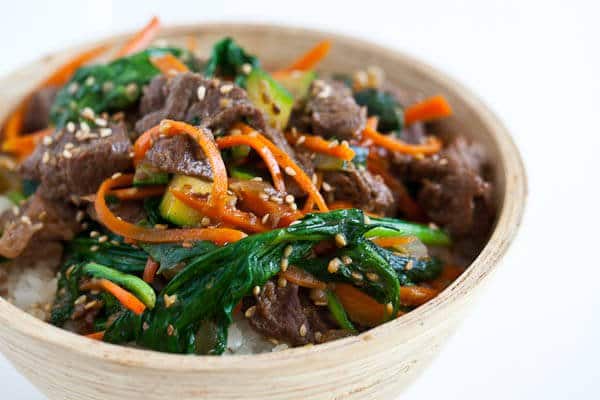
Ingredients:
2 cups raw rice1 pound beef (see headnote)2 tablespoons soy sauce1 teaspoon sesame oil1 teaspoon grated fresh ginger1 garlic clove, finely minced1 tablespoon brown sugar1 1/2 tablespoons cooking oil1/2 onion, diced1 large carrot, cut into matchsticks (or 1 cup matchstick cut carrots)1 small zucchini, diced2 handfuls of spinach leaves1 tablespoon roasted sesame seedsDirections:
1. Cook the rice according to package instructions. See How to Cook Perfect Rice recipe on Steamy Kitchen. If using basmati, see this recipe.
2. For the beef, if using flank steak: Cut the steak into very thin slices ACROSS the grain. If using other steak: Cut the steak into very small cubes, about 1/2-inch. If using ground beef: leave as-is.
3. In a large bowl, combine the soy sauce, sesame oil, ginger, garlic and brown sugar. Add the beef and toss to coat. Let marinate while you prep the vegetables. Steps 1 and 2 can be done ahead of time up to 1 day before.
4. Heat a large saute pan or wok on medium heat. When hot, swirl in the oil. Add the onions and saute for 1 minute. Turn the heat to high and give it just a few seconds to heat up. Add in the beef, spreading the beef all over the surface of the pan, tossing with the onions. Saute for 2-3 minutes until just barely pink.
5. Add in the carrots, zucchini and toss. Cook for 1 minute. Toss in the spinach and cook for an additional minute. Sprinkle with sesame seeds. Serve with rice.
Beef Congee (Rice Porridge)
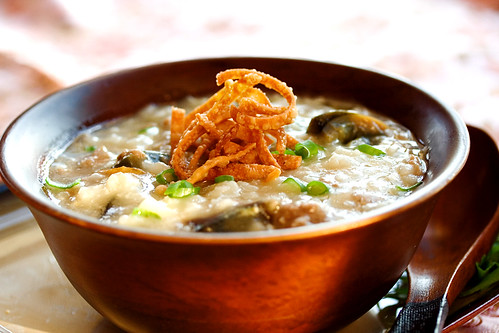
1 cup raw rice
½ lb ground beef (marinated in 1 tbl soy sauce, 1 tbl cornstarch, ½ tsp Chinese cooking wine or dry sherry)
2 cloves garlic, minced
2 tbl dried shrimp (optional)
10 c water or stock
1 ½ tbl soy sauce + ground pepper to taste
Toppings: minced scallions, cilantro, deep fried wonton skins, shredded ginger or Thousand Year Egg (optional of course)
½ lb ground beef (marinated in 1 tbl soy sauce, 1 tbl cornstarch, ½ tsp Chinese cooking wine or dry sherry)
2 cloves garlic, minced
2 tbl dried shrimp (optional)
10 c water or stock
1 ½ tbl soy sauce + ground pepper to taste
Toppings: minced scallions, cilantro, deep fried wonton skins, shredded ginger or Thousand Year Egg (optional of course)
1. Wash rice, drain and repeat 3 more times until the water runs clear. Marinate the beef for 10 minutes. Soak dried shrimp in ½ c hot water and drain.
2. Heat large stockpot over med-high heat with 2T cooking oil. When hot, add ground beef, dried shrimp and garlic. Fry until ground beef is browned. Add the stock or water, soy sauce and rice. Turn heat to high. When boiling, immediately turn heat to low.
noblepigdotcom
Beef Doenjang Jjigae, Korean soy bean paste stew with beef
beyondkimcheedotcom
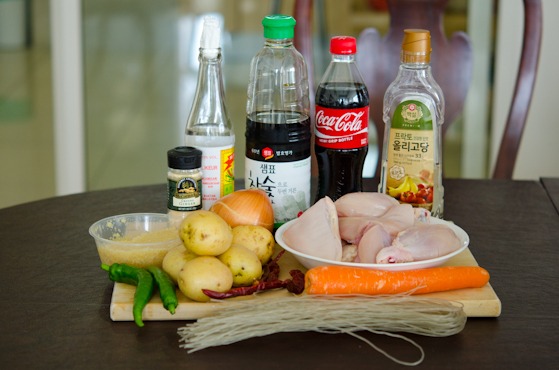 Here are the ingredients you need; soy sauce, cola (coke), rice wine, Korean corn syrup (optional, I ended up not using it), garlic, ginger, chilies, potatoes, carrots, onion, sweet potato noodles and chicken, of course. I trimmed the skin from the chicken pieces only because I am not a huge fan of skin. You don’t need to if you don’t care about it.
Here are the ingredients you need; soy sauce, cola (coke), rice wine, Korean corn syrup (optional, I ended up not using it), garlic, ginger, chilies, potatoes, carrots, onion, sweet potato noodles and chicken, of course. I trimmed the skin from the chicken pieces only because I am not a huge fan of skin. You don’t need to if you don’t care about it.
Slice the cucumber very thinly.


beyondkimcheedotcom
Ingredients
2 cups rice starch water *
2 tablespoon Korean soybean paste, doenjang
1 teaspoon Korean chili paste, gochujang
1/4 lb (100g) thinly sliced marbled beef with some fat attached, cut into big bite size
1/2 onion, diced
1 small yukon potato, diced
3-4 small shitake mushroom, stem removed and diced
1/2 small zucchini, sliced
1 clove garlic, finely minced
1 teaspoon Korean chili flakes, optional
1 green chili, sliced
1 green onion, sliced
Directions
- Pour 1/2 cup of rice starch water in to a small pot. Smear the soybean paste to breakdown all the big chunks of the paste to incorporate with the water. Add the Korean chili paste in a same manner. Add the rest of the rice starch water to the pot and mix well.
- Add the the beef slices and bring the pot over med-high heat to boil.
- What the stock is boiling add the onion, potato, mushroom and continue to boil for 2 minutes.
- Add the zucchini, tofu and garlic, green chili. Add the red chili flakes at this stage if you wish. When the potatoes and zucchinis are tender, remove the pot from heat and sprinkle green onions.
- Serve hot with rice. Be careful! It is boiling hot.
- * To make rice starch water: Rinse rice once and discard the water. Swoosh the rice in a bowl with your hand for 20 seconds and add the 2 1/2 cup of water to the bowl. Swirl around and you will see milky water. Reserve the milky water to use as a stock base. Continue rinsing the rice couple more times and cook rice in a usual way to serve.
Cola Braised Korean Chicken
 Here are the ingredients you need; soy sauce, cola (coke), rice wine, Korean corn syrup (optional, I ended up not using it), garlic, ginger, chilies, potatoes, carrots, onion, sweet potato noodles and chicken, of course. I trimmed the skin from the chicken pieces only because I am not a huge fan of skin. You don’t need to if you don’t care about it.
Here are the ingredients you need; soy sauce, cola (coke), rice wine, Korean corn syrup (optional, I ended up not using it), garlic, ginger, chilies, potatoes, carrots, onion, sweet potato noodles and chicken, of course. I trimmed the skin from the chicken pieces only because I am not a huge fan of skin. You don’t need to if you don’t care about it.
First, soak the Korean sweet potato noodles (dangmyeon) in the warm water until ready to go. Set aside.
Bring a pot of water to boil. Add the chicken and let the water to come up to boil again. Turn off the heat and remove the chicken from their hot bubble bath.
Here they are. Nice and clean. Why do I pre-boil the chicken? To get rid of some gunk and to reduce the gamy poultry smell in the sauce. They are basically just blanched.
Now, grab a braising pot. Pour your coke.
Add soy sauce, rice wine, garlic, and ginger (either fresh or powdered). Mix well.
Add the chicken pieces and chilies. I used dried chilies. Dried chilies are great to use in braising and they tend to bring spicier kick to the dish. You can use fresh chilies if you can’t find the dried kind.
Add your vegetables chunks. I left my potato in whole since they are small. Don’t cut your vegetable too small. You need to adjust your braising time or when to add the vegetables depends on the size of your vegies.
Cover with a lid and simmer over med-low heat for 20 minutes.
The meat and the vegetables are almost fork tender.
Add the soaked noodles and green chilies (if you like).
Continue to braise, UNCOVERED, stirring once or twice, about 5-7 minutes over medium heat. When you see the sauce gets reduced and the noodles are soft, it is done.
Let everything to rest for a few minutes so the liquid will soak through the noodles and to all the other yummy stuff in the pot.Cola Braised Korean Chicken
Let everything to rest for a few minutes so the liquid will soak through the noodles and to all the other yummy stuff in the pot.Cola Braised Korean Chicken
Ingredients
1 kg (2.2 lb) bone-in chicken pieces, trimmed and cleaned
100g Korean sweet potato noodles (aka dangmyeon)
1 lb small whole potatoes (size of a baby fist. Cut into big chunks if large)
2 carrots, cut into 1 1/2" chunks
1 large onion, diced
4-7 dried red chillies or fresh chilies without the stem
500ml cola (preferred Coca-Cola)
1/2 cup soy sauce
2 tablespoon rice wine
1 tablespoon minced garlic
1/2 teaspoon powdered ginger or 1 teaspoon fresh minced ginger
Directions
- Soak the Korean sweet potato noodles in warm water to soften. Set aside.
- Bring water to boil in a medium pot. Add the chicken pieces and let the water come up to boil again. Remove the chicken from water. Set aside.
- In a braising pot combiner Coke, soy sauce, rice wine, garlic, ginger together. Return the chicken to the mixture and add the dried chillies.
- Bring to boil. If you see any scums on the surface, scoop out with a spoon to get the clear sauce. When the whole thing comes to boil, add the potatoes, carrots and onions to the pot, and stir to coat evenly. Cover with a lid and simmer over medium-low heat for 20 minutes.
- Raise heat to medium or medium-high, add the noodles and continue to cook for another 5-7 minutes, uncovered, stirring once or twice. When you see your sauce gets reduced by half and the vegetables are tender, it is done.
- Let the stew rest for a few minutes before serving so the flavor will settle into everything in the pot.
- Serve warm with a little rice.
Nuhbiani, the easy royal Korean beef
The best cut for this dish is strip loin or rib eye with good marbling. Ask your butcher to slice about 1/4″ thickness.
Poke here and there with the tip of your knife.
Slice your meat into 1 1/2″ x 2″ rectangular shape or any big bite size you desire.
Now here are the glorious seasoning ingredients; from left to right. honey, rice wine, sou sauce, sesame oil, pepper, ginger, kiwi, and garlic. Add onion to the list.
Traditionally Korean pear is used in most beef recipes, but I can’t get the winter fruit in this tropical land. Kiwi will work great since its acidity will dramatically break down the muscles. You will need just a little bit.
Spread the sauce evenly all over to the beef slices. Let them sit for 25-30 minutes on room temperature.
25 minutes feels like an eternity if you have to wait. Especially when you want to EAT!
While waiting, chop some nuts finely. I recommend to use pine nuts but walnuts are okay, too.
Don’t omit the nuts. They do add nice texture and flavor to this dish. Unless you are allergic…
Time to broil the beef! Place a cookie rack over a pan lined with foil (easy clean-up later on…). Grease the rack with a spray.
Place under the preheated broiler about 4 inch below the heat source.
Broil about 4 minutes. Watch carefully so you don’t burn them.
They will come out like this. Flip to the other side, and continue to broil, about 3 minutes on the other side.
Collect some meat juice with a brush…,
and brush over your meat. Gives nice shine and keep them moist.
Present your meat on the prettiest platter your own and sprinkle with nuts. And enjoy with some lettuce, rice, and kimchi.
Mac-Jeok, the Royal Korean Pork
I used very thinly sliced cuts for this recipe but you can use thicker slices (up to 1cm).Here is how:
Pork, Asian chives, doenjang paste, rice wine, Korean corn syrup, Korean soy sauce for soup, pepper, sesame oil, and sugar.
Chop up your Asian chives or green onion.
Here is doenjang paste made of fermented soybeans. Very earthy!
If you never smelled it before, don’t try it. It will turn you off. Just saying…
Mix doenjang and all the rest of the ingredients in a large mixing bowl.
Add the chopped chives and mix well.
Dump your pigs in and toss all together with your hand so that the meat gets covered with the sauce evenly.
Hint: If you take out the meat (thawed) from the fridge just before you toss in, you will want to let this mixture sit for 10-15 minutes so the meat can come up to a room temperature.
Meanwhile, preheat your broiler in the oven.
Place a cookie rack over your pan and spray with grease so the meat won’t stick to the rack.
Spread your meat whatever way they let you.
Place your pan in the oven about 3-4″ below your heat source.
Set the timer for 6 minutes. You need to check often to make sure you don’t burn them.
ADJUST the time according to your oven.
After about 6 minutes, flip the meat to the other side so they cook evenly.Broil for another 5-6 minutes.When you see the edges of the meat gets browned and crisp, they are done.
Here is an optional side dish you can serve with, a spicy Asian leek salad.
Cut Asian leek into 3″ long and give a slit on one side to remove the cores.
Note: Asian leek is far tender than regular leek. If you can’t find them, substitute with green onion and slice them diagonally very thin.
Flatten the leek pieces and slice into very thin (1/8″) matchsticks.
You will need a very sharp knife to slice them thinly.
You will need a very sharp knife to slice them thinly.
Soak them in ice cold water with 1 tsp vinegar for 10 minutes or longer.
This will add crispness to the leek.
This will add crispness to the leek.
Combine the dressing ingredients and mix well.
Take them out of water and drain thoroughly.
Rinse the rice once, just once okay?
Add a little bit of water and start tossing the rice rapidly, with swirling motions, for 30 seconds.
You will see the water turning into milk-ish.
Add about 2 cups of water to the rice and swirl around.
You will see the water turning into milk-ish.
Add about 2 cups of water to the rice and swirl around.
Drain to save this milk-ish water into a bowl, about 2 cups.
This is what we call, “ssal-tte-mool (쌀뜨물)”, the rice starch water.
This will enrich the stew.
Now go ahead rinse the rice a couple more times and cook by your usual way.
This is what we call, “ssal-tte-mool (쌀뜨물)”, the rice starch water.
This will enrich the stew.
Now go ahead rinse the rice a couple more times and cook by your usual way.
Here are our ingredients of the day.
Doenjang paste, Korean chili flakes, onion, zucchini, garlic, dried anchovies, sea kelp, mushroom, chilies, and Asian leek or green onion.
But I am missing one important thing…
Doenjang paste, Korean chili flakes, onion, zucchini, garlic, dried anchovies, sea kelp, mushroom, chilies, and Asian leek or green onion.
But I am missing one important thing…
This one, the tofu! I used soft tofu but you can use firm if you like. Cut into cubes.
Dice your onion,
and the same goes to zucchini…
Cut off the bottom from the enoki mushrooms. You can use any mushroom of your choice.
If you want to stick to the authentic style, use a stone pot. This small pot is about 1 quart size.
Bring to your heat source.
Bring to your heat source.
Toast your anchovies for 1 minute.
The reason is that most dried anchovies are stored in the fridge or freezer and they get damp, which means, fishy!
Toasting will remove the fishy smell.
The reason is that most dried anchovies are stored in the fridge or freezer and they get damp, which means, fishy!
Toasting will remove the fishy smell.
Pour the rice starch water and add the dried sea kelp. Let them boil and simmer for 5 minutes.
Remove our sea friends and discard them.
Add the Doenjang (soy bean) paste.
You need to mash them down to incorporate with stock. Whatever left in the mash, throw them back into the stock.
You can use coarse mash strainer for this job or use the back of a spoon and smash it to the pot.
You need to mash them down to incorporate with stock. Whatever left in the mash, throw them back into the stock.
You can use coarse mash strainer for this job or use the back of a spoon and smash it to the pot.
Add onion and zucchini slices,
and chili flakes. Let it boil.
Add tofu and garlic.
Add chilies and boil for 2 minutes.
Ingredients
2 cups rice starch water*
6-7 dried anchovies
1 piece (3") dried sea kelp
2 generous Tbsp Doenjang (soybean paste)
1/2 package (4 oz) tofu, cut into 1" cubes
1/2 onion diced
1/2 zucchini diced
1 tsp Korean chili flakes
1 garlic clove chopped
1 green or red chili sliced
1/2 package enoki mushrooms or one handful of any mushrooms sliced
1/2 Asian leek or 1 green onion sliced
* rice starch water : rinse rice once with water and drain. Add a 1/2 cup of water again, toss and swirl around the rice for 30 seconds. You will see the water turning into milk-like. Add 2 cups of water and swirl to collect all the starch from the rice. Drain to save the starch water in a bowl.
Directions
- Bring small 1 qt stone or heavy bottom pot over medium-high heat. Toast the anchovies for 1 minute and pour the rice starch water to the pot. Add the sea kelp and bring to boil and simmer for 5 minutes. Remove the anchovies and sea kelp, discard them.
- Using a coarse mesh strainer, mash the Doenjang paste into the pot so it gets incorporated with stock. Add onion, zucchini, chili flakes and let them boil. Add tofu, garlic, chili and cook for 2 minutes.
- Lastly add Enoki mushrooms and green onion. Remove the pot from heat and serve hot with rice
Bibimbap,
I used 6 vegetables this time. From the red color to clockwise, radish, shitake mushroom, zucchini, mungbean sprouts, fern, cucumber. You can always choose other types of vegetables such as spinach, carrot, lettuce, soy bean sprouts, eggplants, squash, etc. Color is important in the dish. Eat with eyes before eat with mouth. Think of contrast in vegetable colors.
T
고사리(gosari) is dried wild fern.
Soak mushrooms and ferns in the water. Mushrooms can get out of water in 2-3 hours but the fern has to stay in overnight. They are very, very dehydrated.
Now, it is time to make loads of Namool!
Peel the radish. Slice thinly and cut into 1/8″ sticks.
Add 2 tsp salt and 2 tsp sugar. Let it sit for 10 minutes.You will see some moisture has been extracted. Rinse and drain the radish.
Add 1 Tbsp anchovy sauce, garlic, chili flakes, sesame seeds, chopped green onions(optional).
Toss well with hand. Set aside. #1 done!
Cook mung bean sprout in boiling water for 3 minutes, drain. Toss with salt, sesame oil, sesame seeds, garlic, Korean soy sauce and shrimp powder (optional). Set aside. #2 done!
Slice the cucumber very thinly.
Sprinkle some salt and let it sit to wilt for 10 minutes. Rinse and drain.
Saute in a little bit of oil, add pinch salt and sesame seeds. Make sure you keep their vibrant green color. #3 done!
Cut zucchinis into 2″ logs and peel the green part of the skin carefully from the side. Discard the white part.
Slice them into about 1/4″ sticks. If you are not comfortable peeling off the skin, just slice the whole zucchini into whatever size you like.
Saute them in oil, add salt, garlic, sesame oil, and sesame seeds until they get softened yet still green. #4 done!

Remove the stem of mushrooms and slice them into strips.
Saute them in oil with 1 tsp Korean soy sauce, garlic, sesame seeds and some chopped green onion. #5 done!
Once the ferns are re-hydrated, you need to cook them in simmering water for 40 minutes to soften.
Drain and cut off about 2″ off from the stem ends part. They are too woody!
Drain and cut off about 2″ off from the stem ends part. They are too woody!
Place them in a bowl, add 1 Tbsp Korean soy sauce, garlic, and shrimp powder (optional), and sesame oil. Toss them well with hand.
Saute them as well until slightly tender. Add some green onion and sesame seeds. #6 done!
Whew!!!! That’s all for the vegetables. You can make these ahead of time and store in the fridge. Just bring to the room temperature before you serve.
Don’t forget to make the “Chili bibim sauce” to go with!
Don’t forget to make the “Chili bibim sauce” to go with!
To assemble: Place hot rice in a individual serving bowl, then arrange Namools in contrasting color manner. Dot with sauce, and put fried egg on top if you like.
Tip #1: If you would like to eat as Dolsot Bibimbap (the sizzling hot stone pot), use any individual stove proof cast iron, stone, or clay pot. Just grease the pot with some oil, assemble the dish, and place on the high heat. You will hear the sound of rice sizzling in it. Remove from heat and serve asap.
Tip #2: I know some people have trouble mixing the dish. Use chopsticks to toss all the vegetables and sauce with rice together first. Then use a spoon to finish up.
I ate it all, every single one… and I ate it again for dinner with my family. I ate it next day as well for lunch. And I still crave my bibimbap.
Just random words of the day.
I happened to eat my Bibimbap when I was watching TV news.
My thoughts and prayers are with the families of victims of Arizona gun shootings.
My heart was aching to hear the death of a 9 yr old girl.
She happened to have the same birthday as mine.
Longing for the peaceful world to live in…
The End!
The End!
Ingredients
#1 :
1 1/2 lb Korean radish (moowoo)
2 Tbsp Korean chili flakes + 1 Tbsp anchovy sauce + 1 tsp chopped garlic + 1 Tbsp chopped green onion (optional) + 1 tsp sesame seeds
#2 :
1 lb mung bean sprouts (sookju-namool)
2 tsp Korean say sauce + 1/4 tsp salt + 1/2 tsp garlic + 1/4 tsp shrimp powder (optional) + 1/2 tsp sesame oil + 1 tsp sesame seeds
#3 :
1 English cucumber
2 tsp oil + pinch salt + 1/2 tsp sesame seeds
#4 :
2-3 zucchini or 1 if whole piece is used
2 tsp oil + 1/2 tsp shrimp powder or shrimp sauce (optional) + 1 tsp Korean say sauce + 1tsp garlic + 1/2 tsp sesame oil + 1 tsp sesame seeds
#5 :
8-10 dried shitake mushrooms, need to soak in water for 2-3 hours
1 Tbsp oil + 2tsp Korean soy sauce + 1/2 tsp sesame oil + 1/2 tsp sesame seeds + 1 Tbsp chopped green onion
#6 :
3 oz dried wild fern (gosari), need to soak in water overnight
1 Tbsp Korean soy sauce + 1tsp garlic + 1/2 tsp sesame oil + 1/2 tsp sesame seeds + 1 Tbsp oil + 1 Tbsp chopped green onion
Freshly cooked short grain rice (Korean or Japanese) : about 1 cup per serving
6-8 eggs (optional) : fried, sunny side up
Chili Bibim Sauce : about 1 Tbsp or more per serving
Directions
- #1 : Peel radish, slice thin and cut them into 1/8" sticks. Place them in a mixing bowl, add 2 tsp salt and 2 tsp sugar. Toss and let it sit for 10 minutes. You will see some liquid extracted. Rinse the radish with water once and drain well. Place them back in the bowl and add its seasoning ingredients. Toss well and set aside.
- #2 : Cook the mung bean sprouts in boiling water for 3 minutes, drain and place in a mixing bowl. Add the seasoning ingredients and toss. Set aside.
- #3 : Cut the cucumber in half lengthwise and slice each half very thin half moon shape. Place them in a bowl and add 1 tsp salt and let it sit for 10 minutes. Rinse with water once, drain and squeeze out a little. Heat oil in a skillet over medium heat and stir quick, sprinkle salt and sesame seeds, for 1-2 minutes. Remove from heat and set aside.
- #4 : Cut zucchini into 2" logs. Using a knife cut off the green part around the zucchini from the side, discard the white part. (If you are not comfortable of doing this cutting, just use 1 whole zucchini) Slice the green part of zucchini into 1/4" sticks. Heat oil, add zucchini and stir fry for 1 minutes. Add the seasonings and fry until it gets soften keeping the green color.
- #5 : Soak the mushrooms in water for 2-3 hours. Remove from water and squeeze out excess water. Slice them thin and cook in the oil with its seasoning until soft, about 3 minutes. Set aside.
- #6 : Soak the fern in water overnight. Cook them in a simmering water for 40 minutes until it gets re-hydrated. Drain and rinse. Cut off the woody end part (about 2-3") and discard. Cut the fern 2" slices. Place the fern in a bowl and add Korean say sauce, garlic, sesame oil. Toss with a hand. Heat oil in a skillet, add seasoned fern and stir fry for 2-3 minutes. Add sesame seeds and green onion. Set aside.
- To serve, place rice in individual serving bowl or pot. Arrange vegetables contrast in color manner on top of the rice. Place fried eggs on top and dot with sauce. When ready to eat, mix like crazy!
- Note: You can prepare each vegetables ahead of time and keep in the fridge. Bring to the room temperature before you serve.
Chili bib im bah sauce::::::You will need; ground lean beef, Korean chili paste, honey, sesame oil, Asian pear, onion, garlic, sugar(optional), corn syrup(optional), rice wine or Mirim. Add sesame seeds in this group as well.
Cut up onion and pear, put them in the blender with garlic, Puree their lives.
Pour the puree in the pan, add beef and 1Tbsp sugar (optional).
Cook the beef in puree, smashing with spatula over medium heat. You don’t want any big chunks of beef in the sauce. Well, doesn’t look so appetizing at this point…
Now, time to drop the bomb. The gochujang! Only 1/2 cup but add more if you dare. Mix!
Add honey. The amount is up to you depends on how sweet you want your sauce to be. Don’t make it too sweet. Mix well and let the sauce thicken as you stir over medium low heat. They will thicken more as they rest in the fridge.
Turn off the heat. Drizzle sesame oil and add sesame seeds. Add corn syrup for some shine.
Chili Bibim Sauce (yak gochujang)
Ingredients
1/4 lb lean ground beef
1/4 large onion or 1/2 small onion, cut up
1/2 Asian pear, peeled and seeded, cut up
2 small garlic cloves
1 Tbsp sugar (optional)
1/2 cup Korean chili paste, gochujang
2-3 Tbsp honey
1 tsp sesame oil
1 Tbsp sesame seeds
2 tsp corn syrup (optional)
Directions
- Put onion, pear, and garlic in a blender and puree until smooth. Pour the puree to the pan, add ground beef and sugar (if you wish). Cook over medium heat. Smash the beef with spatula to remove any clumps as you cook.
- When the beef is cooked and the mixture is brownish in color, add gochujang and mix well. Add honey and thicken the sauce over medium low heat for 3-5 minutes. Don't thicken too much. The sauce will get thicken even more as it rest and stored in the fridge.
- Remove from heat, drizzle sesame oil, add sesame seeds and corn syrup for shine. Mix well until combined. Store in a airtight container in the fridge for a couple of month.
- Note: Serve as Bibimbap sauce or topping for plain rice.
Bulgogi Hotpot
If you need a recipe for Bulgogi, click here.
For the stock;
Dried anchovies, dried mushrooms, dried sea kelp, dried dates, and black peppercorn.
Of course I forgot another ingredient in the photo.
Add rooted tips of green onion.
Add rooted tips of green onion.
Here they are.
Combine with water, boil and simmer for 5 minutes.
Let it sit for 20 minutes, covered, so that all the flavor will ooze out.
Grab some Dangmeon, Korean sweet potato noodles, aka, Japchae noodles.
Soak them in the boiling hot water for 10 minutes.
They will relax and soften their attitudes.
While waiting, prepare vegetable of your choice.
I happened to have spinach, oyster mushroom, onion, and red chili in my fridge.
Cabbage, zucchini, bokchoy, and tofu are good choices as well.
Hmmm…, The stock looks fabulous after 20 minutes.
Strain the stock but reserve the mushrooms and the dates.
Sayonara to anchovies and kelp…
Oh, don’t forget to season the stock with soy sauce and rice wine.
Slice the mushroom.
Dates are for garnish later.
Place drained noodles on the heavy bottom pan.
Arrange vegetables and the marinaded Bulgogi the way you like.
Pour the gorgeous stock over, about half way in the pot.
Let it boil.
Taste the broth to see if it is seasoned right.
You can add more soy sauce or salt.
Boil until the beef is just cooked.
You can spread the meat around to cook evenly.
You can spread the meat around to cook evenly.
Do not overcook. This is not a stew.
Taste the soup.
You will be amazed how Bulgogi marinade and
the stock mingle the flavor each other.
the stock mingle the flavor each other.
Ingredients
For the stock
5-7 dried anchovies
3-4 dried shitaki mushrooms
2-3 dried sea kelp slices
3-4 dried dates
4-5 white parts of green onion including the roots
2 tsp black peppercorn
4 cup water
2 Tbsp soy sauce
1 Tbsp rice wine
For the hotpot
1/2 lb (220g) Bulgogi marinaded
1/4 lb (150g) Dangmyeon
handful spinach cleaned
handful mushroom of your choice cleaned and sliced,
1/2 onion sliced
salt and pepper to taste
some green onion and red chili for garnish
Directions
- For the stock, in a medium sauce pan combine all the ingredients EXCEPT soy sauce and rice wine.
- Bring to boil, reduce the heat and simmer for 5 minutes covered. turn off the heat and let it sit for 20 minutes so the flavors will get intensified.
- Strain the stock through a mesh, reserve the mushrooms and dates, but discard the other fillings.
- Slice the mushrooms and the dates, set aside.
- Meanwhile fill the large mixing bowl with water and let it boil in the microwave. Add the Dangmyeon noodles into the bowl and soak them for 10 minutes. They will get soften and flexible. Drain and set aside
- In a 2 qt heavy bottom pot or Korean stone pot, place the noodles on the bottom of the pot. Add the spinach, onion, mushrooms over the noodles. Place the marinaded Bulgogi in the middle.
- Pour the reserved stock over them until the stock will reach to just to cover the vegetables, about half way in the pot.
- Bring them to boil spreading the meat around to cook evenly. taste the broth to see if you need to adjust seasoning. You will need some more salt and pepper. Only cook until the beef is just cook through, about 2 minutes.
- Add the reserved dates on top with some red chili and green onion for garnish.
- Serve immediately. All you need is some Kimchee on the side. Enjoy!
maangchidotcom
Braised chicken with vegetables (Dakjjim)Ingredients for 4 servings:

Chicken thighs, starch noodles, soy sauce, oyster sauce, rice syrup (or corn syrup), dark brown sugar, vegetable oil, dried red peppers, potatoes, garlic, cucumber, green onions, carrot, white mushrooms, onion, green chili peppers, red chili peppers, ground black pepper, sesame oil, andsesame seeds.
Directions:
Total preparation time: 50 mins to 1 hour.
Prepare chicken and noodles:
- Trim the excess fat from 3 pounds of chicken thighs (or breasts or wings) and cut them into bite-sized pieces (1 inch x 2 ½ inches).
- Rinse the chicken in cold water and soak it for a few minutes. Drain and set aside.

- Soak 100 grams (3.5 ounces) of starch noodles in cold water.
Make sauce:
- Combine ¼ cup soy sauce, ¼ cup oyster sauce, ¼ cup rice syrup (or corn syrup), and 1 tbs dark brown sugar in a bowl. Set aside.

Prepare vegetables:
- Cut 3 peeled medium sized potatoes into 1½ inch thick chunks.
- Slice 1 medium sized carrot into slices 1/8 inch thick.
- Slice 1 medium sized onion.
- Chop up 1 red chili pepper and 2 green chili peppers.
- Slice 1 cup’s worth of white mushrooms into bite-sized chunks.
- Cut 5-7 green onion stalks into pieces 2 inch long.
- Shred the white parts of the green onions thinly lengthwise, and soak in cold water for 10 minutes before draining.

Let’s cook!
- Heat up a wok or a shallow skillet. Add 1-2 tbs vegetable oil.
- Cut 2-3 dried red peppers into pieces ½ inch long. Add them to the heated oil and stir-fry for 10-15 seconds before taking them out.

- Add the chicken.
*tip: to prevent yourself from getting burned from flying oil, first place the chicken on the edge of the pot and then push it in with a wooden spoon.
- Stir the chicken with a wooden spoon a few times. Let it cook with the lid open for about 3-5 minutes.
- Turn the chicken over, give it a quick stir, and let it cook with the lid open for another 3-5 minutes.
- Add minced garlic and ginger and stir it for a minute.

- Add the potato chunks, the sauce, and 2½-3 cups of water. Cook for 10 minutes over high heat with the lid closed.

- Open the lid and add carrot and onion and continue cooking for another 10 minutes. Keep the lid open.

- Add soaked and drained starch noodles, sliced red pepper, green chili peppers, white mushrooms, and cucumber. Keep stirring for 7-10 minutes over high heat until the braising liquid has thickened and the noodles look translucent.

- Turn off the heat and add 2 ts ground black pepper and 1 tbs sesame oil. Mix it together
- Transfer to a serving plate and garnish with chopped green onions and sprinkle some sesame seeds over top before serving.
Total preparation time: 50 mins to 1 hour.




*tip: to prevent yourself from getting burned from flying oil, first place the chicken on the edge of the pot and then push it in with a wooden spoon.




Kimcheese Rice Patties, Kimchee + Cheese
Revealing my glorious ingredients!
Mozzarella cheese, Feta cheese, Kimchee, ground pork, parsley, green onion, eggs, flour, and panko crumbs.
You will also need some cooked short grain rice and Parmesan cheese.
Squeeze your Kimchee to death to remove their juice.
Chop Ms. Cabbage as fine as you can.
Saute the piggies in the hot oil until they are no longer shy in pink…
Chop the greens…
Add the chopped Kimchee and fry until it gets softened, about 6-7 minutes over medium heat.
When the Kimchee gets nice and soft, add green onion and parsley.
Remove from the heat. Let it cool down for a few minutes.
Add Mozzarella cheese and feta cheese, stir well.
Add Parmesan cheese and pinch salt to rice and mix well.
Take some rice onto your hand and flatten it. Scoop the Kimchee mixture over rice.
Take more rice and cover the top. Gently squish it to mold into shape. Prepare your coatings for deep frying.Coat with flour, egg, and panko crumbs.
Deep fry them, babe! about 170ºC until NGB (Nice and Goden Brown).
Version 1 finished.
Version 1 finished.
Version 2 : Want to know how you can pan sear these patties? Super easy…
Just press onto Parmesan cheese on both sides.
Sear with a little bit of oil over hot skillet until NGB.
Ingredients
1/2 lb fermented cabbage kimchee
1 Tbsp olive oil
1/3 lb ground pork
1 green onion, chopped
3 Tbsp parsley, chopped
1/2 tsp freshly ground black pepper
3/4 C shredded mozzarella cheese
1/2 cup crumbled feta cheese
3 cups cooked short grain rice
1 cup grated Parmesan cheese, divided
pinch salt
flour, eggs, and panko bread crumbs for coating
oil for deep frying and/or pan sear
Directions
- Squeeze out the kimchee to remove its juice, chop finely.
- Heat the skillet over medium heat, add oil and saute ground pork until brown. Add kimchee and continue to saute until kimchee gets softened, about 6-7 minutes. Remove from heat, add black pepper, green onion and parsley, toss. Rest the mixture to cool down for a few minutes. Add mozzarella cheese and feta cheese, mix well, and set aside.
- In a mixing bowl, combine rice with 1/3 cup Parmesan cheese and pinch salt.
- Grease your hand with a little oil. Scoop some rice, about 2 Tbsp, on the palm of your hand and flatten it with the other hand. Put 1 1/2 Tbsp of kimchee mixture on top of the rice. cover with more rice over the kimchee and make sure to cover the kimchee completely. Gently squish the rice patties to make into desired shapes.
- For Deep frying, coat the patties with flour, egg and panko breadcrumbs. Deep fry in 170ºC oil until golden brown.
- For pan seared, press the patties onto the rest of the grated Parmesan cheese both sides. Heat a little oil in the skillet and sear the patties until it creates golden crust, about 3 minutes on each side.


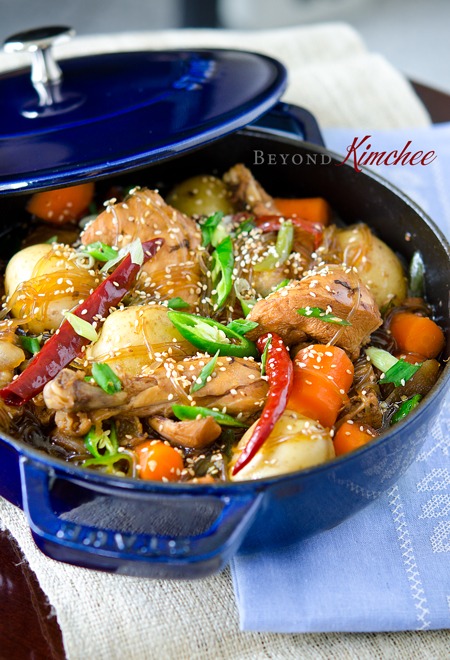

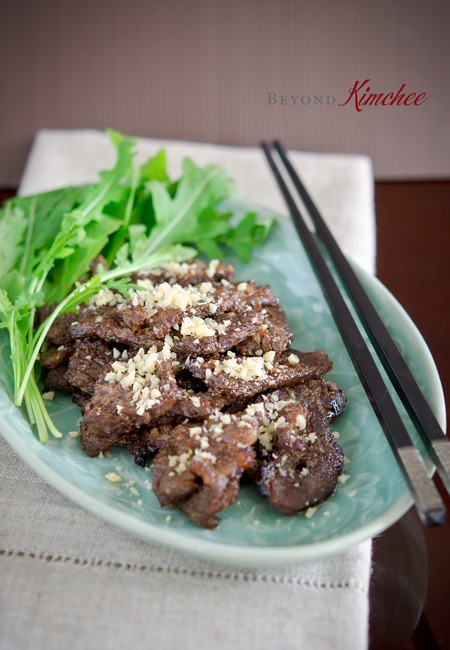



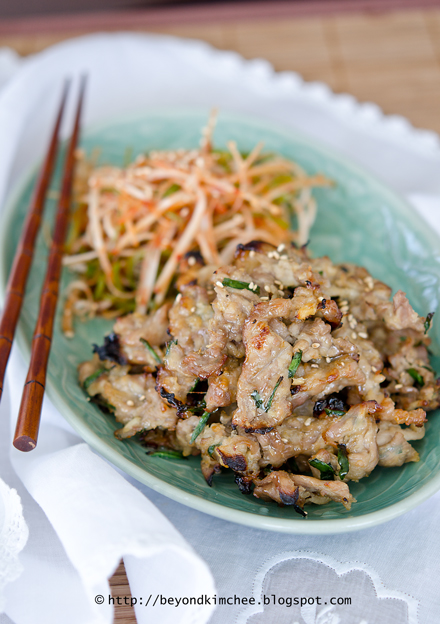
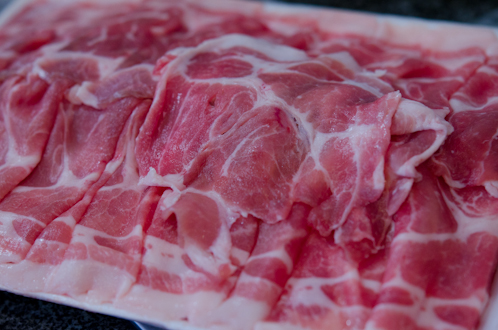
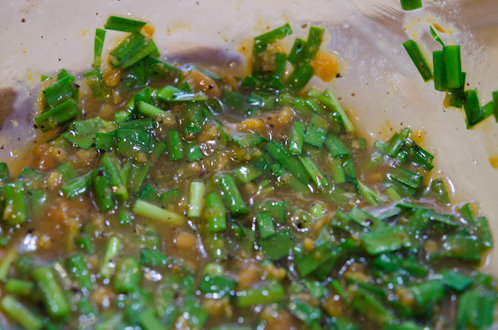


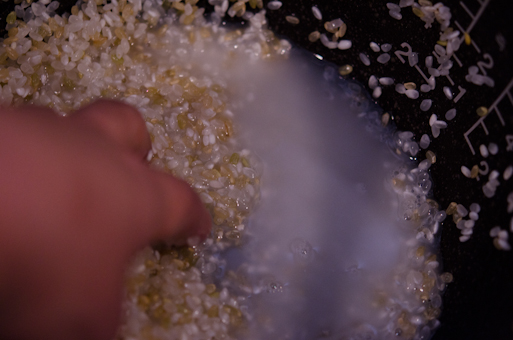
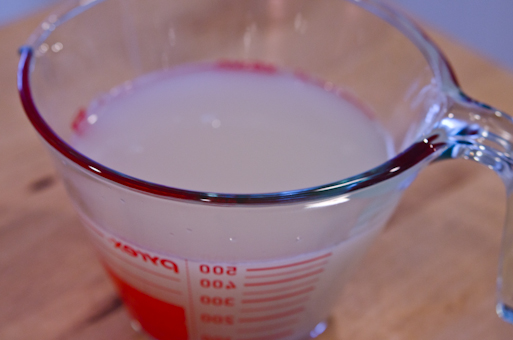
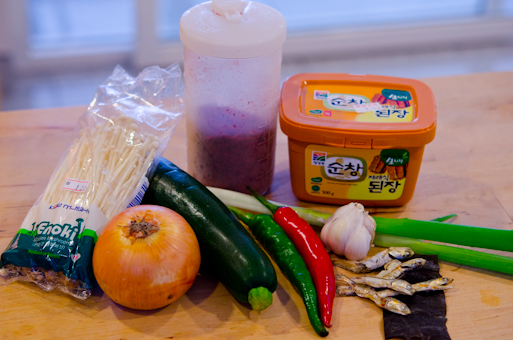
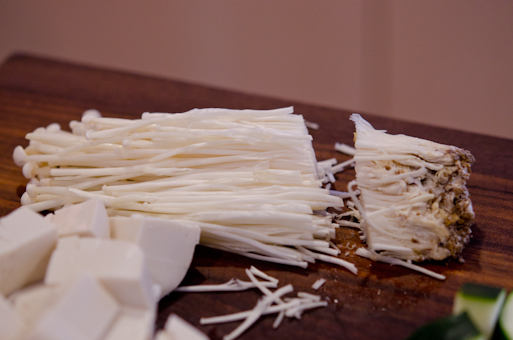
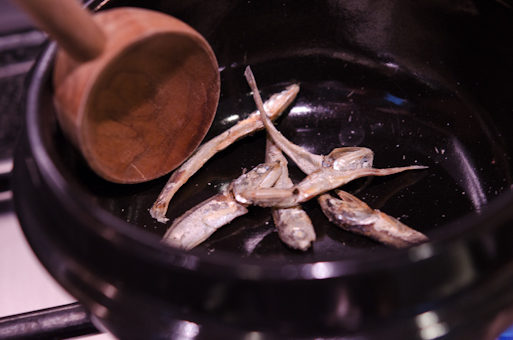

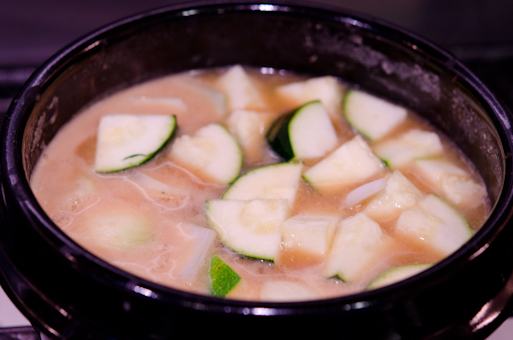
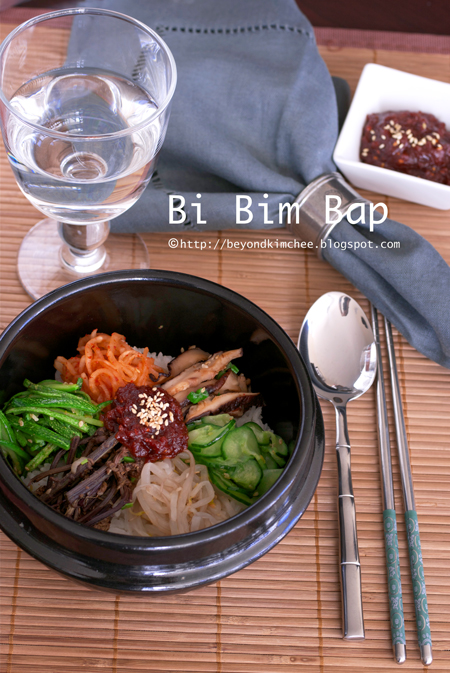
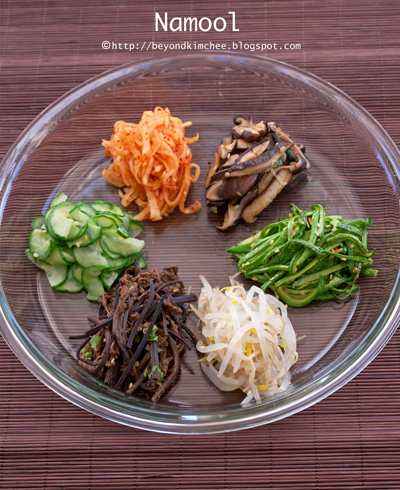
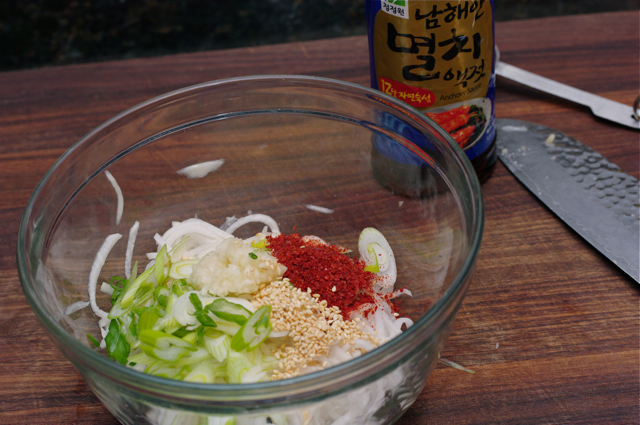

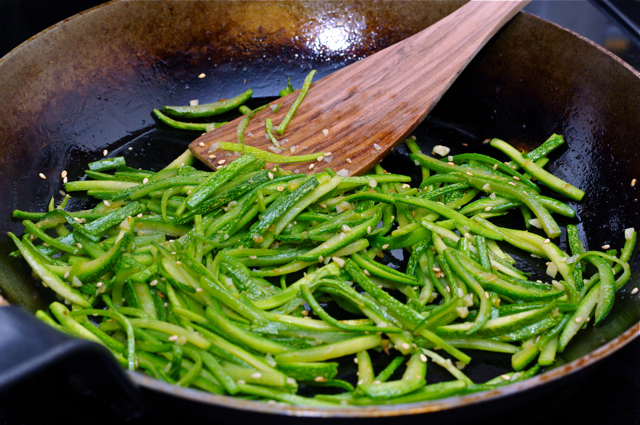
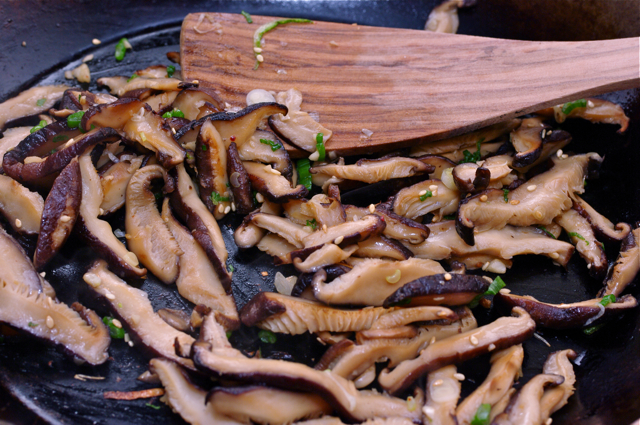


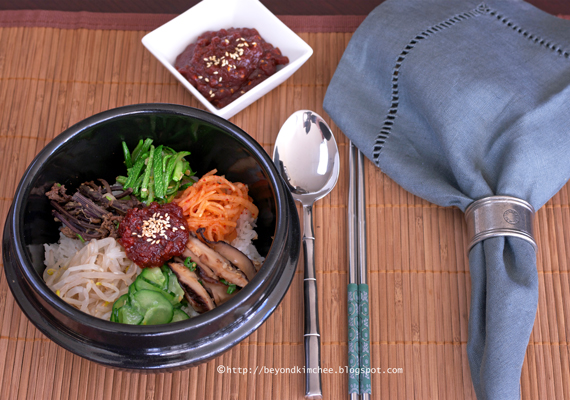
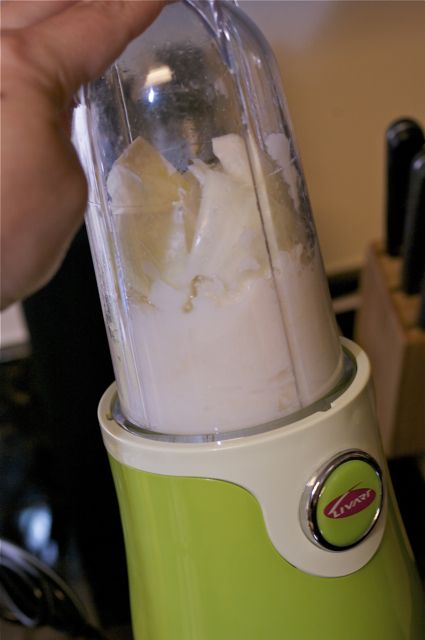
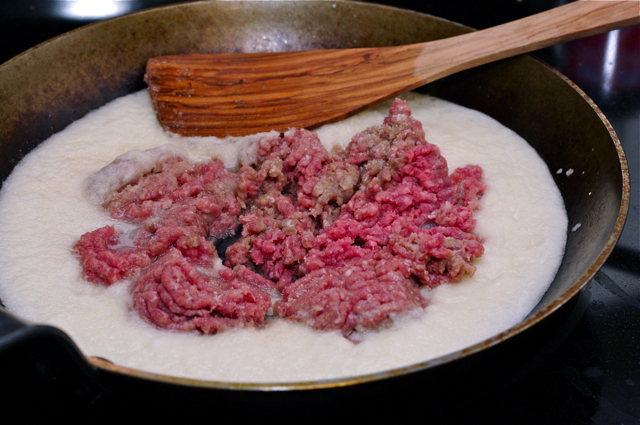
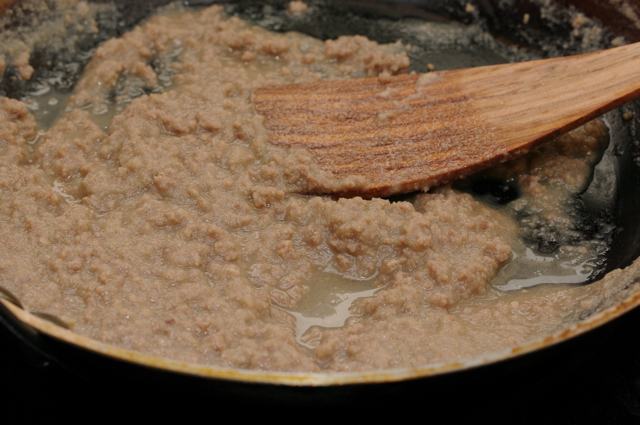
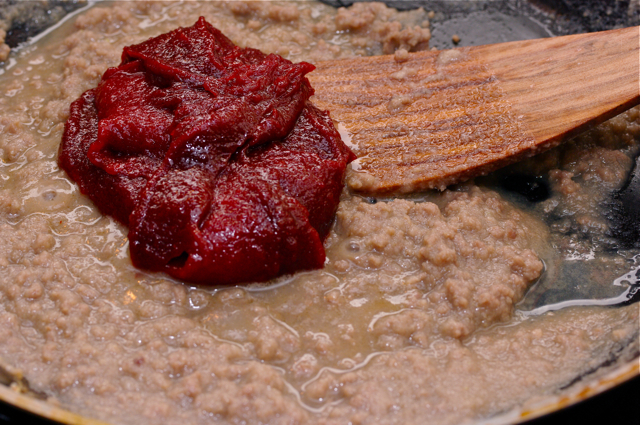
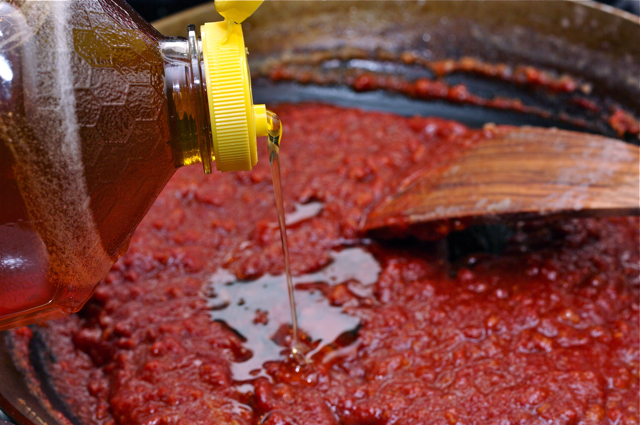
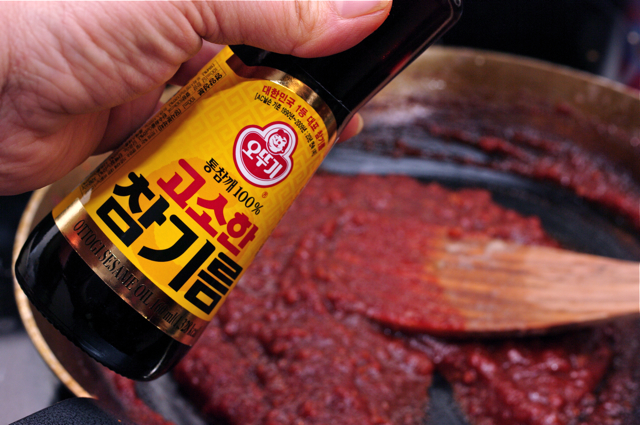










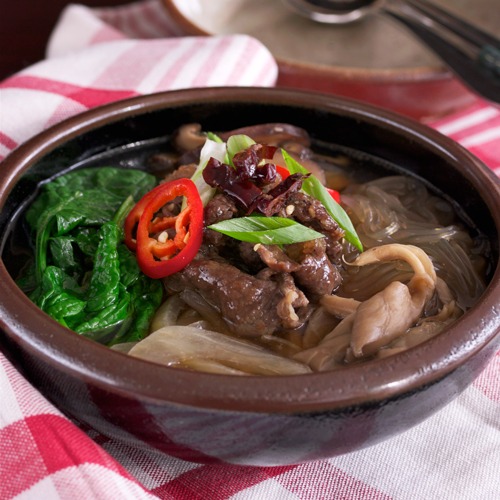










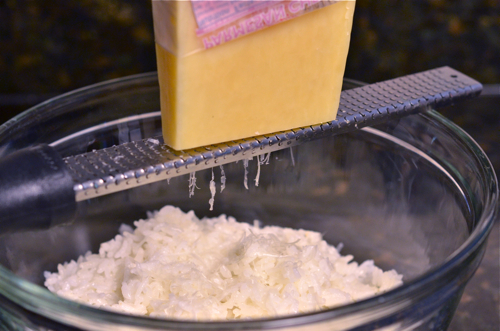


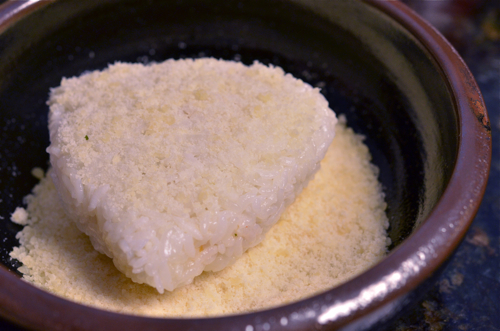

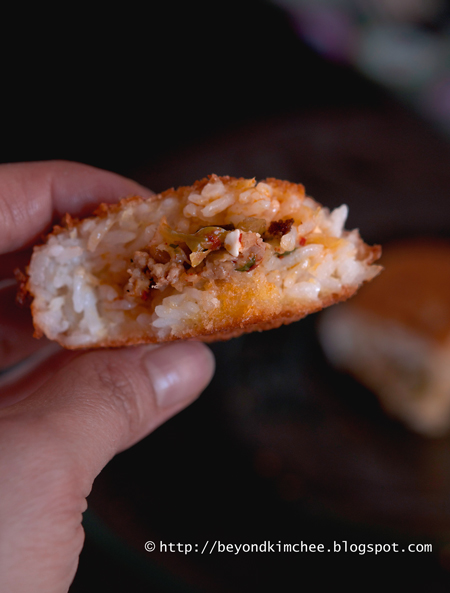
No comments:
Post a Comment